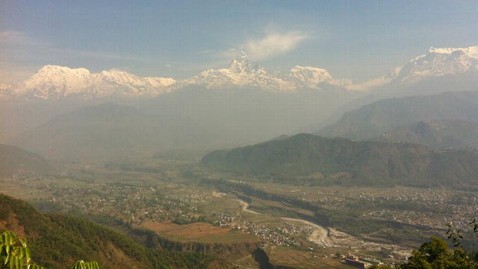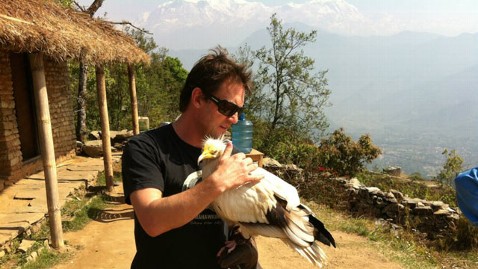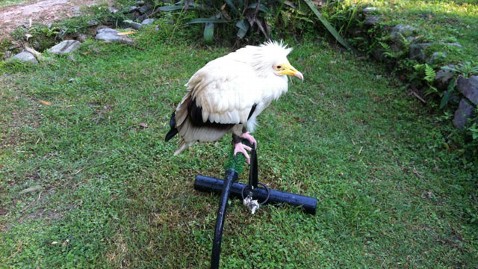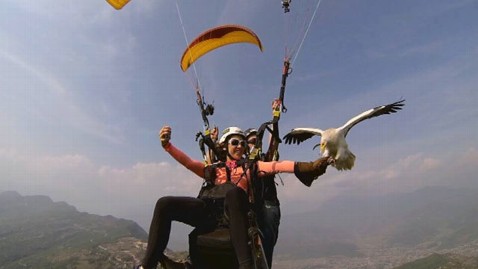Parahawking: Paragliding With Vultures in Nepal
I'm suspended in a paragliding harness, the majestic Himalayas glowing in the distance and an Egyptian vulture comes to eat from my hand. Surreal doesn't begin to describe this journey.
This trip was a year in the making, a dream born while I was taking my first flight off the side of a mountain in Valle de Bravo, Mexico. My photographer on that shoot, Niels Dachler, had for years been trying to get someone to do a story from the paragliding World Cup Superfinal. No one bit until I did, and I bit hard. We not only covered the paragliding World Cup in Mexico that year, but the following year in Colombia where Niels became not only photographer but producer. Over dinner one night in Mexico, our friend and top U.S. paraglider Nick Greece started talking about paragliding and parahawking in Nepal. He showed us this .
I was sold. I needed to get to Nepal and check out parahawking. Little did I know the gravity of the situation.

The Himalayas. Credit: Ginger Zee/ABC
Some species of vultures are nearly extinct in Nepal. Tens of thousands have died in the last decade because of an inexpensive anti-inflammatory drug given mostly to cattle. When the cattle die, some 200 vultures feast on their remains and within 24 hours every single vulture develops kidney failure and dies.
While vultures are one of the most revolting birds and rarely revered in any culture, they are absolutely necessary in our circle of life. Without vultures, the rotting meat contaminates land and water and as a result, Nepal has an increased number of rabid dogs and rats (when the vultures don't eat the dead animal, the dogs and rats do).

Scott Mason with Kevin, the vulture. Credit: Ginger Zee/ABC
This is all part of the reason Scott Mason started parahawking. Just as we have the ability to swim with the dolphins, Scott wanted people to feel close to and care about birds of prey especially given their current ecological situation. He is a falconer and bird enthusiast who started this business to prove that these birds of prey need our help so they do not become extinct.
Leaving from New York City, I flew Qatar Airlines and I had to fly through Doha, Qatar. Once I arrived in Doha, I had an eight-hour layover and the airline provided a hotel room. I wish I could have stayed a bit longer. The skyline in Doha makes you feel as if you're on a different planet. So modern and fresh and so on the other side of the world.
From Doha I jumped over to Katmandu, Nepal. I arrived in the afternoon, greeted by Nick, Niels and our local guides and good friends Isabella and Jaime Messenger. We had a few hours before our next flight to Pokhara, Nepal, so we took a quick trip to the monkey temple. Here, we are made aware that it is Holi Day.

Credit: Ginger Zee/ABC
Holi Day is a huge festival when Nepali people fill the streets and color each other with powdered paint. Strangers literally walk up to you and put paint all over your face. What struck me here was how comfortable people were with monkeys - almost as we are with squirrels. Atop the temple the colorful prayer flags and the prayer wheels gleaming in the sun contrast vividly with the dusty landscape below - millions of people in this small space.
Our short flight to Pokhara was intense and we landed and were taken to town where we would stay. The next morning we traveled to Maya Devi - a small compound with a cafe, bird training facility and living quarters for Scott Mason, his crew, and, most importantly, the aviary for the birds.
The vultures, Bob and Kevin, are much cuter than you would expect. Their spiky hair looks as if it has been gelled straight up on top of their heads. Their coloring is more like a seagull than the brown/black/grey you see in other species.

Photo of Kevin. Credit: Ginger Zee/ABC
Tracy Jacobs is on staff and jumps right in, teaching us the morning routine. She starts by taking the birds out, weighs them, checks them for overall health and then puts them on an outdoor perch to absorb sun.
Tracey tells us that each of the birds have personalities. Kevin, the Egyptian vulture, is a little older and reminds Tracey of a grumpy old man. Bob, she sees as more of a teenager: He likes to sleep in. The Egyptian vulture is a very trusting bird.
Scott Mason arrives and it is time to get up the mountain. To my surprise, Kevin, the vulture, will be joining us in the taxi. Scott added, "Yes, it's a means to an end for him. At the end he gets to fly and gets fed."

Kevin takes a ride. Credit: Ginger Zee/ABC
Scott is a little like their father. First and foremost, he runs a rescue facility. When a bird is found in a compromised position, they always try to get it back into the wild if at all possible. If not possible, they give it the best life it can have.
Once we get to the top of the mountain we will inevitably run off, Scott gives me the lowdown.
"We want you to cover the food because his eyesight is very good," he said. "We will let him fly for a bit, take on piece of food from the pouch and put it in between your thumb and forefinger like this. As soon as you get the food out, keep it there and covered. I will blow the whistle two times, put your left arm out as far as it can go. Most important thing is [that] your arm [is] nice and sturdy, like a branch on a tree, I should say."
With a fanny pack full of buffalo meat, we got hooked up to fly tandem. We start climbing the thermals (pockets of warm air rising from below) and so does Kevin. Then the whistle blows and 3, 2, 1, Kevin is on my arm and quickly takes the meat from my hand.

Credit: ABC News
We land and it's time to fly again. Bob will sub in for Kevin. He flies a bit differently, lingers a bit on my arm. I get a sense that we are not as smooth as they are - when they are flying we are a joke to them.
After the first day's flight we had the unbelievable experience of seeing Scott's other brain child, the "vulture restaurant."
In a village called Gatchot, we parked at the top of a cliff and walked along a river. Scott and a local guide tell us the river flooded last year, killing thousands of people and animals. This vulture restaurant was made so birds of prey have somewhere to eat clean food, free of that murderous anti-inflammatory treatment that has killed so many vultures.
We have to approach quietly because we don't want to interrupt their meal - and vultures have great eyesight. When we get there, they are already feeding on one carcass - a stillborn calf that was brought out to feed them.
It is far less disgusting and much more fascinating then I could have imagined. The bones lying around is a bit eerie, the birds big and dinosaur like.
After flying with the trained vultures and seeing the wild birds eat, I certainly have a new appreciation for these birds of prey. Scott, Nick, Niels, Bella and Jaime: Thank you for helping me, and hopefully others, see the beauty in this beast.
Niels Dachler is a freelance producer for ABC News, as well as a paraglider pilot and filmmaker. His documentary series, " Skydancers," chronicles "unplugged" folk aviation in America. Episode 1 follows the first US paraplegics to fly paragliders.